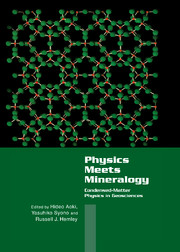Book contents
- Frontmatter
- Contents
- Preface
- List of Contributors
- Part I Introduction
- Part II Advances in Theoretical and Experimental Techniques
- Chapter 2.1 Density Functional Theory in Mineral Physics
- Chapter 2.2 Crystallographic Orbits and Their Application to Structure Types
- Chapter 2.3 Accuracy in X-Ray Diffraction
- Chapter 2.4 Statistical Analysis of Phase-Boundary Observations
- Part III New Findings in Oxides and Silicates
- Part IV Transformations in Silica
- Part V Novel Structures and Materials
- Part VI Melts and Crystal–Melt Interactions
- Subject Index
- Materials Formula Index
- Index of Contributors
Chapter 2.1 - Density Functional Theory in Mineral Physics
Published online by Cambridge University Press: 05 November 2011
- Frontmatter
- Contents
- Preface
- List of Contributors
- Part I Introduction
- Part II Advances in Theoretical and Experimental Techniques
- Chapter 2.1 Density Functional Theory in Mineral Physics
- Chapter 2.2 Crystallographic Orbits and Their Application to Structure Types
- Chapter 2.3 Accuracy in X-Ray Diffraction
- Chapter 2.4 Statistical Analysis of Phase-Boundary Observations
- Part III New Findings in Oxides and Silicates
- Part IV Transformations in Silica
- Part V Novel Structures and Materials
- Part VI Melts and Crystal–Melt Interactions
- Subject Index
- Materials Formula Index
- Index of Contributors
Summary
Density functional theory of the electronic structure of condensed matter is reviewed with an emphasis on its application to geophysics. The review is placed within the context of our attempts to understand planetary interiors and the unique features of these regions that lead us to use band-structure theory. The foundations of density functional theory are briefly discussed, as are its scope and limitations. Special attention is paid to commonly used approximations of the theory, including those of the exchange-correlation potential and the structure of the electronic core. Some of the important computational methods are reviewed, including the linearized augmented plane-wave method and the plane-wave pseudopotential method. Examples of applications of density functional theory to the study of the equation of state, crystalline structure, phase stability, and elasticity of earth materials are described. Some critical areas for further development are identified.
Introduction
Planetary interiors represent a unique environment in the universe in which the behavior of condensed matter presents a considerable challenge. The nature and the evolution of planetary interiors, even that of our own Earth, are complex, poorly understood, and difficult to predict with current theoretical understanding. In contrast, we have a much better understanding in many ways of the interiors of distant stars. For example, we are able to calculate the structures and evolutionary history of stars with some certainty, an exercise that is not yet possible for the Earth.
- Type
- Chapter
- Information
- Physics Meets MineralogyCondensed Matter Physics in the Geosciences, pp. 21 - 43Publisher: Cambridge University PressPrint publication year: 2000
- 1
- Cited by



